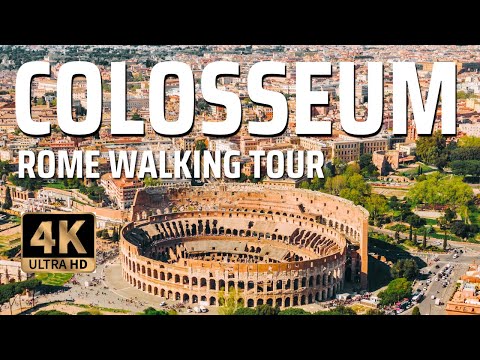Walking Tour 4k, Rome, Italy - Colosseum with Captions

The walking tour starts from Piazza Venezia heading towards the Colosseum Here we are in Piazza Venezia with the Altare della Patria in front of us. The Altare della Patria is the most important monument to the first king of Italy, Vittorio Emanuele II, a symbol of the nation and its democratic and European values. The Athenaeum of Hadrian is an archaeological site from the Roman era located in Piazza della Madonna di Loreto, near Piazza Venezia in Rome. In 2008, with the excavations for the construction of underground line C, the remains of brick rooms were brought to light in the Piazza Madonna di Loreto, which, together with others excavated at the beginning of the twentieth century under the Assicurazioni Generali building, made it possible to rebuild a complex consisting of at least three rectangular classrooms. The future Venice stop is expected to incorporate the archaeological site, which will be visible in the internal atrium through a special glass case The Trajan's Column is a monument erected in Rome to celebrate the conquest of Dacia (current Romania) by the emperor Trajan; in fact, it recalls all the salient moments of that territorial expansion. The cell at the base served as a sepulcher for the emperor's ashes.
This is the first coclide column ever erected. It was located in the Trajan's Forum, in a narrow courtyard behind the Basilica Ulpia between two (presumed) libraries, where a double loggia on either side facilitated reading. The column is of the "centenary" type, that is, 100 Roman feet high (equal to 29.78 meters, about 39.86 meters if you include the high pedestal at the base and the statue at the top). The order of the column is the adapted Doric one, as evidenced by the grooves at the top under the spiral-shaped frieze, the capital decorated with an ovoli kyma and with the base in the shape of a crown on a plinth. The column is made up of 18 colossal blocks of Carrara marble, each of which weighs about 40 tons and has a diameter of 3.83 meters.
They make up the 17 drums, the base, the capital and the abacus. Originally a bronze statue of Trajan was placed on the top. The Trajan's Markets constitute an extensive complex of Roman buildings in the city of Rome, on the slopes of the Quirinal hill. Since 2007 they have housed the "Museum of the Imperial Fora". The complex, which originally extended beyond the limits of the current archaeological area, in areas now occupied by modern palaces, was mainly intended as the seat of the administrative activities connected to the Imperial Forums, and only to a limited extent to commercial activities, which perhaps they took place in the open spaces on the sides of the internal streets. The Forum of Caesar was the first of the Imperial Forums of Rome to be built, with the aim of expanding the spaces of the political, administrative and religious center of the city of the traditional public square of the Roman Forum and at the same time to celebrate the person who had wanted it construction, Julius Caesar. It was one of the very few works in Caesar's urban plan that he was able to inaugurate on September 26, 46 BC, before his death.
However, the complex was not to be completely completed and other works are also testified under the principality of Augustus. Clivo Argentario (clivus Argentarius) is an ancient road in Rome that ran halfway up the slopes of the Capitoline Hill, behind the Forum of Caesar. The current name dates back to the Middle Ages, the ancient one most likely was clivus Lautumiarum. A section of paving is preserved, which starts from the square in front of the Tulliano Prison, just outside the archaeological area of the Roman Forum and reaches the entrance to the Central Museum of the Risorgimento, behind the Vittoriano. The Mamertine prison (or Tulliano prison, in Latin Carcer or Tullianum) is an ancient prison, the oldest in Rome, and is located in the Roman Forum.
It was the symbolic prison for illustrious prisoners of ancient Rome and it is no coincidence that it is located in a very central area, close to the Via Sacra nel Foro. For about a thousand years it hosted in stocks the great enemies of the people and the state, the great vanquished and the great traitors of Rome: from the king of the Samnites Pontius, to the king of the Gauls Vercingetorix, from Peter the apostle to the conspirators of Catiline. It consisted of two superimposed floors of caves dug on the southern slopes of the Capitol next to the Gemonie Stairs, towards the Comitium. The complex is now located under the 16th century church of San Giuseppe dei Falegnami, in the area of the Forum where, in Roman times, justice was administered. The arch of Septimius Severus is a triumphal arch with three arches (with a central passage flanked by two smaller side passages), located in Rome, at the north-west corner of the Roman Forum and stands on a travertine plinth, originally accessible only by stairs. Erected between 202 and 203, it was dedicated by the senate to the emperor Septimius Severus and his two sons, Caracalla and Geta to celebrate the victory over the Parthians, obtained with two military campaigns concluded respectively in 195 and 197-198.
The arch was placed in the Forum and with the arch of Tiberius and the portico of Gaius and Lucius Caesar it constituted one of the four monumental entrances to the historic forensic square that was not passable by wagons: some steps under the arches prevented the passage of the wheels. Via dei Fori Imperiali is one of the most scenic streets in Rome; opened in 1932 with the name of via dell'Impero. It takes its current name from the monumental remains of the forums of Cesare, Augusto, Nerva, della Pace and Traiano which can be admired by walking along it. It connects Piazza Venezia with the Colosseum, which constitutes its visual goal. It is lined with domestic pines, the characteristic "pines of Rome".
In addition to the Imperial Forums, the street overlooks other famous Roman monuments: the Basilica of Maxentius, the Roman Forum, the Trajan's Markets, the Militia tower, the House of the Knights of Rhodes and the eastern side of the Vittoriano. Furthermore, the street leads to the basilica of Saints Cosma and Damiano and to the church of San Lorenzo in Miranda, which reuse, respectively, the structures of the temple of the Divine Romulus and of the temple of Antoninus and Faustina; about halfway along the road, the Tor de 'Conti rises. Since 1950, the annual parade on 2 June has been held there on the occasion of the feast of the Italian Republic. The Temple of Peace (templum Pacis) was an ancient building of worship in Rome, erected at the behest of the Emperor Vespasian between 71 and 75.
From the 4th century AD onwards it received the name of the forum of Peace (forum Pacis), the third in chronological order of the five Imperial Forums. It was located next to the forum of Augustus, separated only by the Argileto road, the ancient road between the Roman Forum and the Esquiline, which was rearranged shortly after under Domitian with the construction of the Transitional forum. Dedicated to the two medical brothers who were martyred in 303 AD, the Basilica of Santi Cosma e Damiano was born in the 4th century from the merger of two classical buildings: one of the two libraries of the Forum of Peace and the rotunda of the so-called Tempio del Divo Romolo. Originally, access was from the Via Sacra, through the portal of the Tempio del Divo Romolo. Today, however, it can be accessed from via dei Fori Imperiali, through an atrium overlooked by a section of the opus quadratum wall of the ancient Bibliotheca Pacis. In 1512, Cardinal Alessandro Farnese entrusted the basilica to the Franciscans of the Third Order Regular of San Francesco, who still live in the place today. The church acquired its present appearance around 1632, during the papacy of Urban VIII. The floor was raised by 7 meters to the new level of Campo Vaccino, creating a lower and an upper church.
The Franciscan cloister built by Arrigucci and decorated with frescoes by Francesco Allegrini representing "Stories of St. Francis and the blessed Lucchese"; rectangular in plan with six arches on the long sides and three on the short sides, all supported by pillars, it has a characteristic fountain with three basins in the center. The apse was decorated with remarkable mosaics around 530, with a scene representing the arrival in the sky of the two saints Cosma and Damiano. In the center is the figure of Christ with a scroll in his left hand and his right hand pointing to a star. On the left are Paolo, Santo Cosma and Pope Felice IV who offer the model of the church, and on the right, Pietro, Teodoro and San Damiano. Below, in the drum, the apostles are represented in the form of sheep. The basilica has a highly symbolic importance, as it represents the first Christian building of worship within the area of the Roman Forum, a true symbol of the power and sociability of imperial Rome.
The majestic apse mosaic has its own celebratory function of this great change, made with precious materials is one of the most important mosaics for scholars of art history, it is one of the last examples of Byzantine art. In 1600 an earthquake hit the basilica and in 1626 by Pope Urban VIII had the Roman walls of the 1st century demolished and replaced. The basilica is divided in two with the construction of the new floor. The chapels and altars have been moved or rebuilt in the new upper church. At the same time, the new buildings of the monastery and a courtyard with arcades were made. In 1632 Pope Urban VIII raised the church by 7 m from the ground level, bringing it to the level of Campo Vaccino (the ancient Roman Forum now used for grazing and the ox market), to avoid water infiltration. The ancient floor of the basilica is still visible today in the "lower church", constituted in the original spaces currently underground.
The Colosseum, originally known as the Flavian Amphitheater, located in the center of the city of Rome, is the largest Roman amphitheater in the world, capable of holding an estimated number of spectators between 50,000 and 87,000, it is the most important Roman amphitheater, as well as the most imposing monument of ancient Rome that has come down to us. The amphitheater was built in the Flavian period on an area on the eastern edge of the Roman Forum. Its construction, begun by Vespasian in 70 AD, was completed by Titus, who inaugurated it on 21 April in 80 AD The structure clearly expresses the Roman architectural and construction concepts of the early Imperial Age, based respectively on the curved and enveloping line offered from the elliptical plan and the complexity of the construction systems. Arches and vaults are linked together in a close structural relationship. The basilica of Maxentius, more properly of Constantine, is the last and largest civil basilica in the monumental center of Rome, formerly located on the Velia hill, which connected the Palatine with the Esquiline. It is not part of the Roman Forum proper (although it is now part of the archaeological area that includes it, extending up to the slopes of Velia), but was in the immediate vicinity of it.
The Meta Sudans was a fountain of the Flavian age, which was located near the Colosseum and the arch of Constantine. It was called meta because of its shape which represented the goal around which the floats had to turn in circus races, and sudans because it seemed to sweat: in fact, the bronze ball that surmounted it was riddled with holes from which the water came out. According to an ancient legend, gladiators used to go to Meta Sudans to wash themselves after the fight in the nearby amphitheater. construction of the Via dei Trionfi. The Arch of Constantine is a triumphal arch with three arches (with a central passage flanked by two smaller side passages), located in Rome, a short distance from the Colosseum. The Arch can be considered as a real official Roman sculpture museum, extraordinary for its richness and importance. The general dimensions of the elevation are 21 meters high, 25.9 meters wide and 7.4 meters deep. The arch was dedicated by the senate to commemorate the victory of Constantine I against Maxentius in the battle of Ponte Milvio (28 October 312) and inaugurated in 315 on the occasion of the ten years of the emperor's reign; the location, between the Palatine and the Celio, was on the ancient route of the triumphs.
The arch is one of the three surviving triumphal arches in Rome: the other two are the arch of Titus (c. 81–90) and the arch of Septimius Severus (202–203). The arch, as well as that of Titus, is almost completely ignored by ancient literary sources and the information that is known derives largely from the long inscription of dedication, repeated on each main face of the attic.
2022-06-06 19:08


